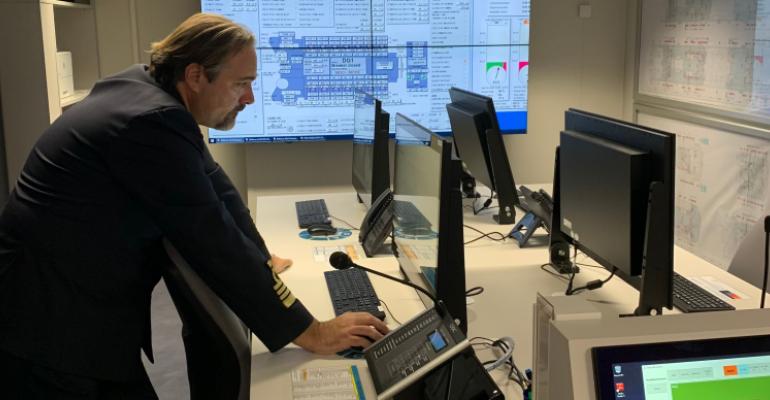The newest ship in the fleet, It is MSC Cruises’ first vessel to run on LNG and also features demonstrator fuel cell technology, a first application of testing in a real time marine environment on a cruise ship.
First glimpse at fuel cell technology
Seatrade Cruise News was among the first media to get the opportunity to see close up some of the technology onboard, mostly located below decks, apart from the fuel cell technology demonstrator which as a plug and play model is located high above any accessible public area near to the funnel.
Around the size of a large container box, the fuel cell is made up of two sections.
Electro-chemical reaction
Capt Minas Myrtidis, VP environmental operations and compliance at MSC Cruise Management (UK) explained how it works in layman’s language: ‘It works on a chemical process...the LNG goes through a heat reforming process to the cell through the anode and then it separates into hydrogen, carbon monoxide, carbon dioxide and steam. On the cathode side there is air containing oxygen and this and the four elements interact together to create oxide irons that carry electricity. That process is taking place in the anode and then they travel though the cathode and produce an electrical current through an electricai circuit.’
The fuel cell on MSC World Europa is producing a very small capacity of the hotel loads daily needs, around 150kW of electricity and is integrated to the shipboard to support the running of the in-cabin HVAC systems and heating the water. ‘It is a very small part of our daily needs if you compare the hotel load is running at around 8-10 MW at any given time, but it allows us to test and monitor how the technology is performing,’ Michele Francioni, SVP cost optimisation and process improvement at MSC Cruises said.
Marine environment trial
Within the next six months MSC will be able to test and record how efficient the fuel cell is and how it performs onboard a ship at sea in particular to the outside temperature, the climate and sea conditions. ‘It has never been trialled in a real-time marine environment,’ commented Francioni.
He added, ‘We are able to produce electricity in a more efficient way compared to the way it is produced in a traditional internal combustion engine and without having the issues related to combustion..it is purely an electro-chemical reaction.’
‘The flexibility afforded by solid oxide fuel cell technology enables us to run it on LNG, hydrogen or methanol dependent on what become available in port,’ added Linden Coppell, the cruise line’s VP sustainability & ESG.
The plan would be to scale up on future newbuilds to increase the capacity whilst continuously monitoring the fuel cell performance at sea.
 L-R: checking on the fuel cell; Linden Coppell in the engine room; thousands of crushed drink cans and wine bottles ready for offloading
L-R: checking on the fuel cell; Linden Coppell in the engine room; thousands of crushed drink cans and wine bottles ready for offloading
Bridge with a view
Staying above board, Capt Marco Massa welcomed us on the bridge – without doubt providing the best view of Doha’s cityscape with its 180 degree floor to ceiling windows.
Housing all the latest safety and navigation technology Capt Massa explained there are no more paper charts on board just computerised navigational charts (with computerised back up) which can be updated on a daily basis if required using software upgrades).
Going deep down into the lower decks, provided a quick look at the ship’s five dual fuel (LNG/traditional marine fuel) Wartsila engines, before heading over to the waste separation area to see the aluminium can and the glass crushers in action.
Bureau Veritas 12 Golden Pearls
Bureau Veritas has recognised MSC World Europa with its 12 Golden Pearls award for sustainability and environmental stewardship. The 215,863gt, 47mtr wide ship with 2,626 cabins, also features selective catalytic reduction system, anti-fouling paints, advanced wastewater treatment plants, LED lighting, desalination plant, smart HVAC, trim optimisation (aided by the use of hundreds of sensors onboard), as well as latest water recycling technology to purify wastewater, sea ballast water treatment system and propellors to reduce underwater noise and its impact on marine wildlife.
A final stop was at the engine room control centre and hang out of Chief Engineer Antonino Gargiulo.
Surrounded by wall to wall computer screens he explained that MSC World Europa took on LNG at Marseille during the recent voyage from the shipyard to Qatar and will be running on LNG for some of the five weeks the ships is berthed alongside in Doha.
Unfortunately there is no shore side power connectivity in Doha to fully utlilise the ship’s latest technologies for the full duration of the time the ship will spend in port whilst being used as a floating hotel for football fans visiting Qatar for the World Cup.
Copyright © 2024. All rights reserved. Seatrade, a trading name of Informa Markets (UK) Limited.
Add Seatrade Cruise News to your Google News feed.  |

